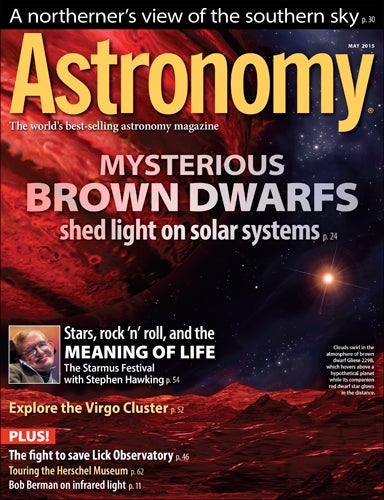Video FAQ page
In “The little stars that couldn’t,” science writer Jesse Emspak explores the mysteries surrounding these odd bodies. Brown dwarfs, usually solitary and glowing only dimly in infrared light, present unique challenges to observers used to studying shining stars or planets in helpful partnerships with stars. The dwarfs’ thick, complicated atmospheres vary greatly with temperature, which can be as low as a few hundred kelvins for the tiniest Y dwarfs and up to a few thousand for the largest L dwarfs. This huge range gives observers the chance to spot water clouds, weather, and complicated chemistry of all different kinds when they can peek into the hearts of these objects. But there are many unanswered questions, including some of the most basic: How bright should these objects be? How old are they? How do they form?
To learn about these mysterious and complicated bodies that are blurring the line between planet and star, pick up the May issue of Astronomy, on newsstands March 27.
“A northerner’s view of the southern sky”
The most breathtaking central sprawl of the Milky Way complements the glow of the Magellanic Clouds only to observers looking up from south of the equator. Is it only the lure of the unfamiliar, or do the southern skies really hold more celestial wonders? Is it possible to compare the south’s Eta Carinae to the north’s Orion Nebula? In “A northerner’s view of the southern skies,” Contributing Editor Stephen James O’Meara pits the two hemispheres against one another in a celestial showdown.
“The fight to save Lick Observatory”
The University of California’s Lick Observatory has been the site of groundbreaking astronomy and instrumentation research for well over a century. Yet in 2013, a decision to defund the observatory in order to focus money on a fewer number of larger, more modern — and less accessible — telescopes at other sites nearly ceased its operations. Associate Editor Eric Betz explores the site’s history and accomplishments, as well as its new battle for survival, in “The fight to save Lick Observatory.”
“Stars, rock ’n’ roll, and the meaning of life”
Rock stars from the astronomy and music worlds, including renowned physicist Stephen Hawking and Queen guitarist and astronomer Brian May, teamed up for the second Starmus Festival in September 2014 in the picturesque Canary Islands. In “Stars, rock ‘n’ roll, and the meaning of life,” Editor David J. Eicher recaptures the celebration of art and space, sharing his experiences of a week that included talks by Nobel-winning scientists, a rock concert, and the biggest telescope in the world.
May sky events visible without optical aid
- May 6 — The Eta Aquariid meteor shower peaks.
- May 7 — Mercury appears at its best in evening skies for northern observers.
- May 22 — Saturn reaches its 2015 peak, shining brilliantly all night.
Also in the May 2015 Astronomy
- “Explore the Virgo Cluster”: May is a great month to explore the center of our local supercluster, and this photo guide ensures you won’t get lost in the crowd.
- “Touring the Herschel Museum”: Both William and Caroline Herschel made significant contributions to the astronomy world, and their historic home and workspace is open for visitors.
- “The Sky this Month”: Exclusive star charts will guide you through May’s night sky.
- The May issue also features Snapshot, Breakthrough, Astro News, Ask Astro, Bob Berman’s Strange Universe, Glenn Chaple’s Observing Basics, Stephen James O’Meara’s Secret Sky, Adam Block’s Cosmic Imaging, Astro Sketching, New Products, Letters, Web Talk, Reader Gallery, and Final Frontier
Astronomy offers you the most exciting, visually stunning, thorough, and timely coverage of the heavens above. Each monthly issue includes expert science reporting, vivid color photography, complete sky-event coverage, spot-on observing tips, informative equipment reviews, and more. All of this comes in an easy-to-understand user-friendly style that’s perfect for astronomers at any level. Contact Astronomy, the world’s best-selling astronomy magazine, at 262.796.8776 or email editor@astronomy.com.










